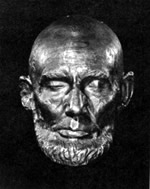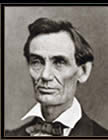An Analytical Biography of a Great Mind- by Edward J. Kempf
- PART I
- PREFACE
- INTRODUCTION
- Chapter 1 - Lincoln's Physical Constitution
- Hereditary Determination
- Hypersensitive Hypokinetic Constitution
- Meaning of Facial Asymmetries
- Fracture of Skull and Injury of Brain in Boyhood
- Diagnosis of Cerebral Lesion
- Diplopia and Eyestrain
- Borglum's Interpretation of Lincoln's Face
- Enigmatical Character of Facial Expression
- Preference for Photographs of Right Side of Face
- References
MEaning of facial asymmetries
| Plate 3  Mill's Life Mask of Lincoln, 1865. Courtesy of Mr. Clarence L. Hay and the American Museum of Natural History |
If we examine the full face photographs{1} of Lincoln, and of the Volk (1860) life mask,{2} and the Mills (1865) mask,{3} we see that the forehead is wide, high and bulges slightly in the middle.
There is an unusual depression in the Volk mask with a palpable edge near the midline above the left eye. I have examined the Mills mask and found a similar depression in its forehead.
In Lincoln's photographs and both masks the left eye sets higher than the right. His left eyebrow is usually elevated more than the right to keep the upper lid retracted and the pupil of the left eye exposed. The tendency of the left eye to turn upward uncovered more of the white surface of the sclera below the iris, giving a slightly dull, weak, staring effect on that side, in strong disharmony with the more active right eye and face. The left eye in the best frontal photographs is shown definitely to be out of focus and turned reflexly slightly upward and outward. This effect is due to the inferior oblique muscle of the eye being stronger than the weakened superior oblique which turns the eye inward and downward. Lincoln's right eye functioned normally and dominantly for general vision and reading. Further examination of the face shows that the left half of the upper lip is somewhat thicker than the right and less expressive, that is, less involitionally and volitionally active. The right half of the lower lip protrudes markedly and is pulled toward the right by the mouth and cheek muscles. This action also characteristically pulls the nose definitely toward the right. The right side of the chin is larger than the left, indicating stronger muscle tonus and development from more active use.* Although his larynx was large, he had a rasping, high pitched voice that grew shrill and squeaky upon emotional excitement, indicating some imbalance of vocal cord or pharyngeal muscle tension.
Further examination of the Volk mask, especially when measured for similar right and left points from the midline, also shows marked differences in the growth of the bones.* Although such differences may be genetic, or developmental in relation to loss of teeth and use, and cannot be taken as definitely indicative of the effects of an injury of the brain in youth like the differences in tonic contraction of the ocular and facial muscles, they should be considered and functionally correlated. His cheek bones were unusually high and prominent. The right was larger than the left, and the right orbital ridge and lower jaw were more heavily developed than the left, giving the whole face a decided morphological curve toward the right.*
This deformation becomes distinctly visible when the full face photographs are turned upside down. When the Volk mask is turned upside down, or viewed from below upward, the larger size of the face and the greater prominence of its lip, chin and lower jaw, and the greater depression of the face under the cheekbone, on the right side, is impressive.*

